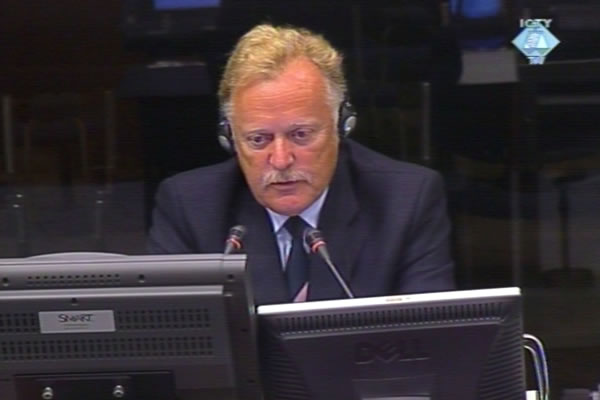Home
WITNESS FORGOT DETAILS
Briton Richard Mole remembers that military observers ‘felt’ that the claims about the BH Army targeting their own people ‘might be true’, but he ‘forgot the details’. In response to those arguments, the prosecution has called yet another British witness, Richard Higgs, an expert on mortars. Having analyzed some shelling incidents, Higgs concluded that the shells had been fired from Serb positions
 Richard Mole, witness at Radovan Karadzic's trial
Richard Mole, witness at Radovan Karadzic's trial Continuing his cross-examination of the former senior military observer from Great Britain Richard Mole, Radovan Karadzic tried to prove that the BH Army ‘opened fire’ on their own people in order to maintain the status of a victim, to gain public sympathy and provoke an international military intervention.
The witness said Karadzic’s claim was ‘good’ but ‘controversial’. As Mole said, ‘there were unknown elements’ in the investigations of some shelling incidents in Sarajevo, and this made the UNPROFOR staff ‘rather certain’ that the claims about the BH Army shelling its own territory were ‘true’.
Mole admitted he couldn’t provide any examples, explaining that military observers ‘were uneasy’ because they ‘felt that the claims that the BH Presidency forces’ – the term Mole used for the BH Army – targeted their own people ‘might be true’.
Karadzic on the other side illustrated his claims with the evidence of Canadian Patrick Henneberry. In his evidence in May 2002 at the trial of VRS general Stanislav Galic, Henneberry said he remembered that ‘Bosnian Muslims shelled their own people’ but he ‘couldn’t remember any details’ and could therefore not be more specific about the locations of those purported incidents.
After Mole, the prosecution called yet another Briton to the witness stand, Richard Higgs. Higgs is a mortars expert. He wrote a report on the shelling incidents in Sarajevo for the prosecution in the cases of Stanislav Galic, Dragomir Milosevic and Momcilo Perisic. Those incidents are also listed in the indictment against Radovan Karadzic.
The prosecutor first tendered into evidence Higgs’s written statement based on his testimony in previous cases. The witness was then asked to comment on the four out of a total of eight shelling incidents he analyzed in his expert report: the shelling of the water queue in Dobrinja on 12 July 1992, the shelling of a playground on Alipasino Polje on 22 January 1994 and two incidents at the Markale market – on 5 February 1994 and 28 August 1995.
Based on the reports of the Sarajevo police, UNPROFOR and the UN military observers, Higgs concluded that in all four incidents the shells had been fired from Serb positions. Analyzing photos taken at the impact site at the Markale market, Higgs determined that the shell had been fired from the Serb positions on Mount Trebevic. The prosecutor went on to show the famous video recording filmed right after the incident. Apart from the horrors at the scene, the video shows French UNPROFOR staff at the crime scene investigating the crater and the remnants of the shell.
At the beginning of his cross-examination, Karadzic expressed his doubts about the accuracy of the report the witness used as a basis for his analysis. He then moved on to the topic of the Markale market incident. Skipping over the heart-breaking parts of the footage, the accused focused on the body of one of the victims, asking why there was so little blood under the body, ‘given that the human body is two parts liquid’.
Karadzic, who is assisted by Serbian weapons expert Zorica Subotic, has asked for 20 hours to cross-examine Higgs. The Trial Chamber has granted Karadzic only three hours. The trial continues tomorrow morning.
Linked Reports
- Case : Karadzic
- 2010-08-17 SARAJEVO WAS A DANGEROUS PLACE TO LIVE
- 2010-07-22 KARADZIC AND SOWS
- 2010-07-21 FEARS OF ‘ETHNIC HOSTAGES’ IN SARAJEVO
- 2010-08-19 KARADZIC: SARAJEVO INVESTIGATIONS WERE ‘IMPROVISED AND SLOPPY’
- 2010-08-20 MLADIC’S DIARIES ADMITTED INTO EVIDENCE
- 2010-09-03 HOW LONG WILL KARADZIC'S TRIAL TAKE
